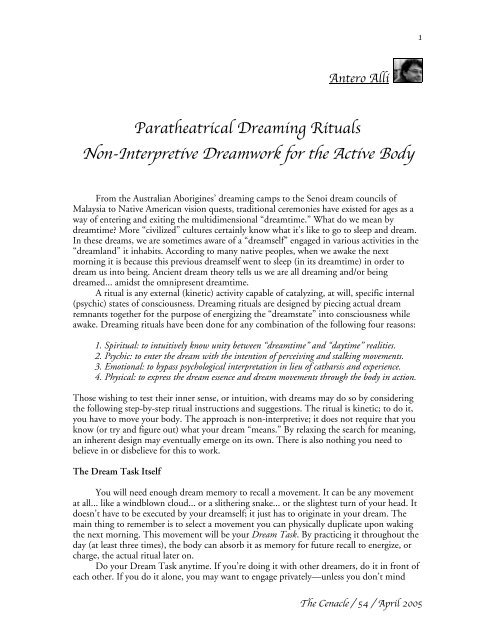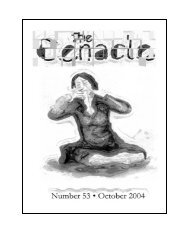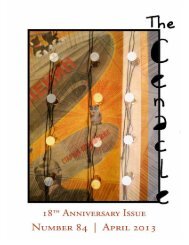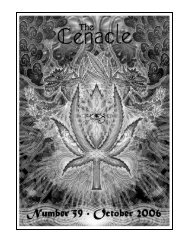Scriptor Press - The ElectroLounge
Scriptor Press - The ElectroLounge
Scriptor Press - The ElectroLounge
You also want an ePaper? Increase the reach of your titles
YUMPU automatically turns print PDFs into web optimized ePapers that Google loves.
Antero Alli<br />
Paratheatrical Dreaming Rituals<br />
Non-Interpretive Dreamwork for the Active Body<br />
From the Australian Aborigines’ dreaming camps to the Senoi dream councils of<br />
Malaysia to Native American vision quests, traditional ceremonies have existed for ages as a<br />
way of entering and exiting the multidimensional “dreamtime.” What do we mean by<br />
dreamtime? More “civilized” cultures certainly know what it’s like to go to sleep and dream.<br />
In these dreams, we are sometimes aware of a “dreamself” engaged in various activities in the<br />
“dreamland” it inhabits. According to many native peoples, when we awake the next<br />
morning it is because this previous dreamself went to sleep (in its dreamtime) in order to<br />
dream us into being. Ancient dream theory tells us we are all dreaming and/or being<br />
dreamed... amidst the omnipresent dreamtime.<br />
A ritual is any external (kinetic) activity capable of catalyzing, at will, specific internal<br />
(psychic) states of consciousness. Dreaming rituals are designed by piecing actual dream<br />
remnants together for the purpose of energizing the “dreamstate” into consciousness while<br />
awake. Dreaming rituals have been done for any combination of the following four reasons:<br />
1. Spiritual: to intuitively know unity between “dreamtime” and “daytime” realities.<br />
2. Psychic: to enter the dream with the intention of perceiving and stalking movements.<br />
3. Emotional: to bypass psychological interpretation in lieu of catharsis and experience.<br />
4. Physical: to express the dream essence and dream movements through the body in action.<br />
Those wishing to test their inner sense, or intuition, with dreams may do so by considering<br />
the following step-by-step ritual instructions and suggestions. <strong>The</strong> ritual is kinetic; to do it,<br />
you have to move your body. <strong>The</strong> approach is non-interpretive; it does not require that you<br />
know (or try and figure out) what your dream “means.” By relaxing the search for meaning,<br />
an inherent design may eventually emerge on its own. <strong>The</strong>re is also nothing you need to<br />
believe in or disbelieve for this to work.<br />
<strong>The</strong> Dream Task Itself<br />
You will need enough dream memory to recall a movement. It can be any movement<br />
at all... like a windblown cloud... or a slithering snake... or the slightest turn of your head. It<br />
doesn’t have to be executed by your dreamself; it just has to originate in your dream. <strong>The</strong><br />
main thing to remember is to select a movement you can physically duplicate upon waking<br />
the next morning. This movement will be your Dream Task. By practicing it throughout the<br />
day (at least three times), the body can absorb it as memory for future recall to energize, or<br />
charge, the actual ritual later on.<br />
Do your Dream Task anytime. If you’re doing it with other dreamers, do it in front of<br />
each other. If you do it alone, you may want to engage privately—unless you don’t mind<br />
<strong>The</strong> Cenacle / 54 / April 2005<br />
1









